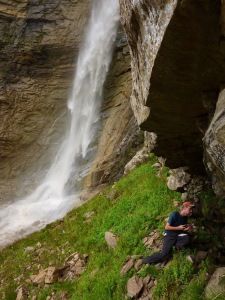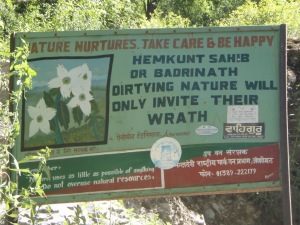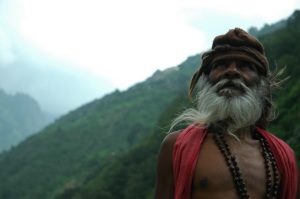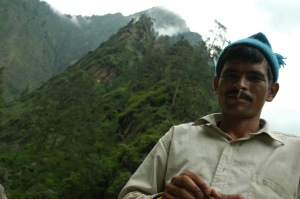The Himalaya were formed from the collision of the Indian subcontinent with Asia. This collision has created the highest mountain chain in the world with Mount Everest reaching 8848 meters (29029 feet) above sea level. In addition to creating the highest mountains in the world, the Indo-Asian collision subducted a large amount of the northern Indian margin to depths of nearly 130 km. To come to this conclusion, Barun Mukherjee and Himanshu Sachan discovered microdiamonds in the Tso Morari eclogite (
Mukherjee and Sachan, 2004).
To explain how these high and ultra-high pressure rocks returned to the surface, Chris Beaumont and Becky Jamieson developed several very elegant models invoking an extrusion of these metamorphic rocks through a ductile mid-crustal channel (
Beaumont et al., 2001;
Beaumont et al., 2009). I went to the Himalaya in India to test these models of ‘channel flow’ by using geothermobarometry, geochronology, and structural geology. The results of my study can be found in the journals: Tectonics (
Spencer et al., in press) and Gondwana Research (
Spencer et al., 2011).
Working in the Himalaya is a wonderful experience. In all my travels, I had never been to a place where everything was so different and new: the people, the language, the food, and the geology. I arrived in New Delhi and immediately made my way to the mountains. After a four day journey by train and car I arrived at Joshimath, Uttarakhand.
 |
| Village of Joshimath |
As you can see in the above picture the roads in and out of Joshimath are quite treacherous. When traveling in the high Himalaya the distance between destinations is always deceiving and the number of switchbacks often triples the ‘as the crow flies’ distance. As the road climbs higher along the switchbacks I could occasionally see vehicles at the bottom of the gorge of unfortunate drivers that slipped off the edge. Despite the arduous journey, the views from Joshimath and the hills above the town are completely worth it (see below).
 |
| View of Dunagiri (left) and Nanda Devi (right) |
Nanda Devi (7816 m / 25643 ft) was considered the tallest mountain in the world until 1808 and remains a very sacred site for the Hindus.
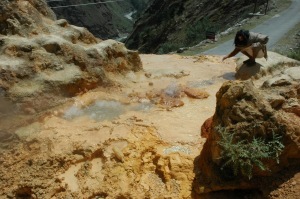 |
| Yogi bathing in hot springs at Topovan |
|
In addition to sacred mountains and hotsprings, the headwaters of the Alaknanda (upper Ganges) found in northern Uttarakhand.

|
| The Holy Ganges |
At the beginning of the Alaknanda river is the town of Badrinath. Badrinath is the last and northernmost “Char Dham” which literally means “the four abodes”. The other four dhams are located at the western, eastern, and southern extremes of India. These four locations have been considered the most sacred sites of Hinduism for over 1200 years.
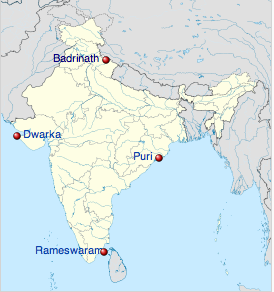 |
| The Char Dham |
Doing field work in the Himalaya was a very different experience than my previous experiences working in the American Southwest. I spent most of my time in India above 10,000 feet and although I was there long enough to become accustomed to the altitude the elevation was an interesting challenge. The weather would often change on a dime. One moment I would have blue skies and the next torrential rains with snow in the evening.
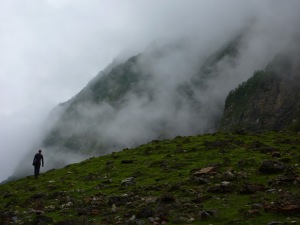
While in the field I was one of the few people who were not there for religious purposes. I was there for garnets! Garnets are possibly the most important mineral for geothermobarometery (determining temperatures and pressures of metamorphism). Because of the resilient nature of garnet, they often preserve the various stages of metamorphism through inclusions and internal compositional zoning.
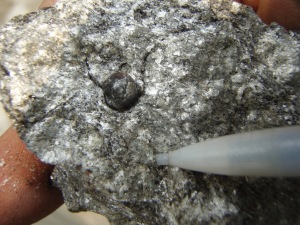 |
| Garnet-mica schist |
 |
| Compositional zoning of garnet from the Greater Himalayan Sequence |
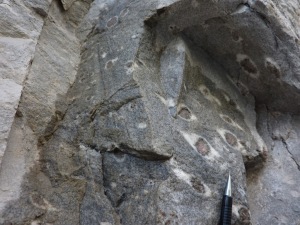 |
| Garnets with strain halos. Notice the halos are unstrained along the left face and highly strained on the right face. |
Garnets are also used in association with other metamorphic minerals (e.g. staurolite, kyanite, sillimanite) to infer metamorphic conditions.
 |
| Garnet (red) and staurolite (black/grey) |
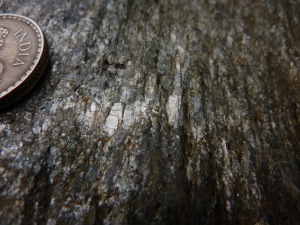 |
| Lathes of mica |
The Hindus are also very conscience of Mother Nature and all that she provides. In a place like Uttarakhand with all its beauty and vulnerability, I can understand why preserving the natural stability is so important.
In the heart of the high peaks of Uttarakhand lies a secluded glacial valley called the Valley of Flowers. In 1988, this valley was named a UNESCO World Heritage Site. Other UNESCO World Heritage Sites include the Necropolis of Egypt, Statue of Liberty, Great Wall of China, and Yellowstone. There are over 500 species of plants many of which have important medicinal purposes and are very rare outside the valley.
 |
| Brahma Kamal (Saussurea obvallata) (from TrekEarth) |
|
|
|
|
Corba Lily (Arisaema speciosum)
|
Other than the garnets, my favorite thing about working in the Himalaya is the people I met: holy men, pilgrims, and farmers of “medicinal herbs”.
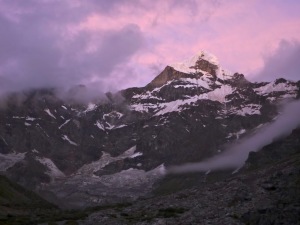 |
| Sunrise over Nilkantha |
After spending nearly five months in the India, I was happy to come home. There are times however, when I miss it. I miss the dahl and curries, temples and shrines, yogis and street hawkers, mountains and rivers (but mostly I miss the garnets).










![]() This work is licensed under a Creative Commons Attribution-NonCommercial-ShareAlike 4.0 International License.
This work is licensed under a Creative Commons Attribution-NonCommercial-ShareAlike 4.0 International License.


